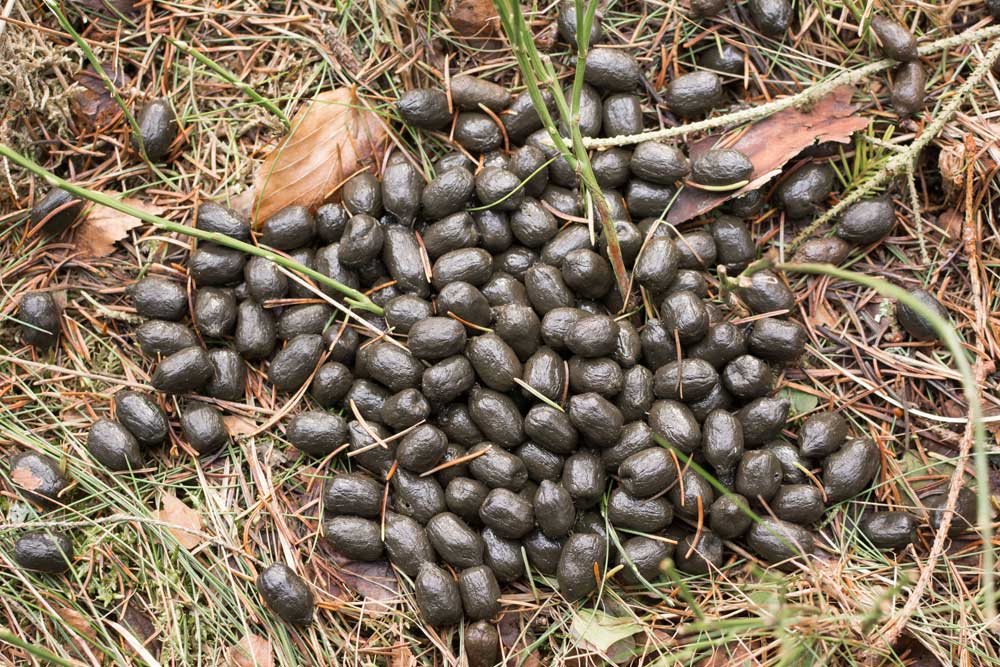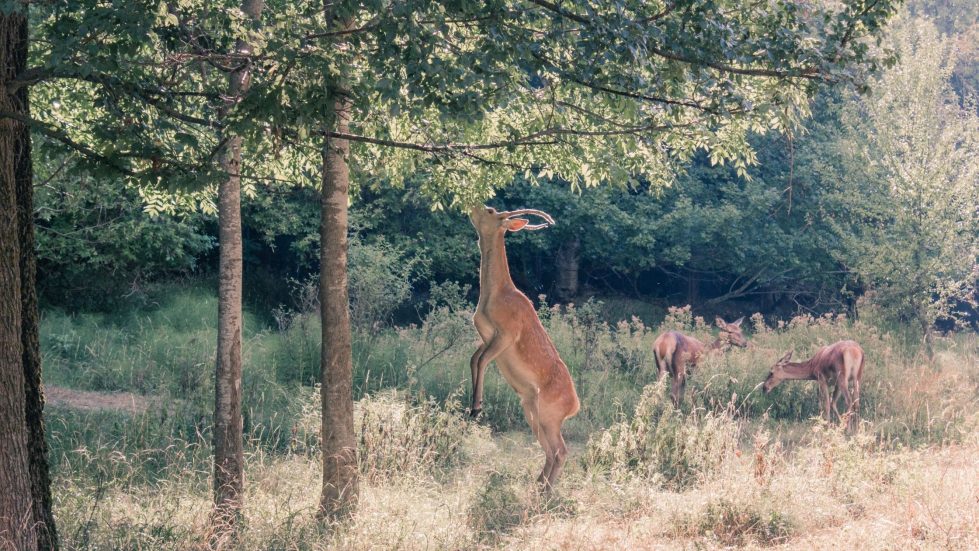Dealing with pesky deer invading your garden or property? Deer will stop at almost nothing to devour your saplings, flowers, fruits and vegetables. Here are some ways to help keep deer out of your garden this Spring and through the winter.
How to Keep Deer Out of Your Garden
Once deer discover your yard is a delicious salad bar, they’ll hop fences, ignore scare tactics, and show up on a regular basis to eat your plants one by one. Even if you think your roses are safe, they’ll walk right up to your house and help themselves.
Famished deer will eat almost anything if it is available to them. There are many ways to keep deer away from your property, but it may take some trial and error to find the best method for your situation. Filling your garden with deer-resistant plants that they naturally avoid is an excellent way to start. First things first, protect plants that they do like.
Foods that Deer Like
Tender greens, such as lettuce, pansies, ivy, and Hosta, are frequently targeted by deer. It appears that deer are particularly fond of spring and early summer flowers like tulips, lilies and roses, too, even if they’re kept in a container. There are a wide variety of fruits available to them, from strawberries to fallen fruit from fruit trees. The bark, twigs, and leaves of most trees and shrubs can be eaten by deer. During the winter, when food is scarce, they can also harm woody plants.
Plants to Help Keep Deer Out of Your Yard
When a plant is poisonous or abrasive or has a strong odor, deer avoid eating it. Even if deer don’t like something, they’ll try it if they’re unsure, so don’t plant anything you’re not sure they’ll like. Choose deer resistant plants when you begin the design process of your garden.

Deer Damage: How to Identify It
Evidence that deer have visited your garden includes nibbled fruits and vegetables, leaves that have been roughly clipped, buds and blossoms that have vanished overnight, hoof prints in the soil, and small piles of round black droppings.

In the winter, deer antlers leave marks on tree trunks and woody shrub branches. Smaller animals can’t score on trees this high because deer can reach leaves up to six feet in the air.
Control Deer Damage
Many homeowners are experiencing significant damage to their expensive ornamental trees and shrubs from deer feeding. Some Wildlife Removal professionals offer a deer repellent program designed to help protect your valuable plantings from being damaged by the expanding number of deer in our area.
Our tried-and-true program combines the use of scent and taste aversions on a regular schedule to discourage deer from damaging your plant material. These products are used to modify deer feeding and help reduce the activity of deer carrying ticks bearing Lyme disease on your property.
Deer Damage Facts
- White-tailed deer feed on gardens, landscape plants and trees, and agricultural crops.
- Deer damage has a rough or torn appearance. It does not look cleanly clipped.
- Deer damage is more likely when deer population numbers are high and environmental conditions are stressful, especially during cold temperatures and deep snow.
- Deer are creatures of habit and often return to the same area. Act early and treat with repellents to discourage their visits and reduce damage.
- Options to prevent deer browsing include protective structures, habitat modification, repellents, hazing, regulated hunting and resistant plants.
Odor-Blocking Deer Deterrents
The effectiveness of DIY odor-based deer deterrents varies depending on how quickly the deer adapt to them. In many cases, a technique’s effectiveness is limited to a few days. Some of the most common DIY deterrents include:
- Mothballs
- Hair
- Dead Fish
- Garlic
- Plants that are natural deterrents
For the most effective odor-based deer deterrent, we recommend using commercial deer deterrent sprays provided by professional wildlife removal companies.
Types of Deer Deterrent Devices
Deer will stay away from your gardens if you use certain barriers and items that disturb or scare them. Reflective surfaces and thorny branches can be just as effective as fences as a deterrent device. These are just a few examples of physical deterrents:
- Thorny vines
- Floodlights
- Automatic Sprinklers
- Fences
- Reflective Deterrents
- Bird and Wildlife Netting

Fences to Protect Your Garden from Deer
A garden fence is one of the most effective ways to keep deer out. There should be no more than six-by-six-inch gaps between the fence and the ground in order to keep deer out. Enclose the entire garden or they’ll try to get around the fence. Keep in mind, deer can jump high! An 8-foot-high fence is also recommended.
Obstacles such as angled netting, tree branches, or thorny shrubs prevent some deer from flying or landing over an 8-foot fence. Alternatively, you could place two 4- or 5-foot-high fences 3 feet apart.
Deer and Bird Netting
To keep birds and deer away from your fruit and vegetable plants, use garden netting to cover shrubs and small trees. A temporary garden fence made of netting and metal stakes is another option. When it comes to keeping deer out of your garden, black deer netting, also known as “invisible netting,” is the best option.
Practicing double fencing will keep deer out of an area even if your fence isn’t that high. a few feet apart set up two lower net fences Shiny streamers can be attached to netting in the same way that reflecting tape, deterrents or pie pans can be hung from trees and shrubs.
Deer Repellant Devices
Whistles and wind chimes can be used to deter deer, which are easily startled. Electric wires are also off-limits to them due to the annoying humming sound they make. List of noise-blocking devices includes:
• Noisemakers
• Flags
• Radios
• Whistles
• Electtrical wires (grid wire)
Professional and DIY Deer Deterrent Sprays
DIY deer-deterrent sprays for plants include some very creative methods such as rotten egg and water, soap spray, and hot pepper spray. Commercial deer repellent sprays come in a wide variety of scents and have proven to be very effective. As much as possible, use organic deer repellent sprays, especially if you have pets, children or livestock. Planting deer-attractive plants or leaving corn for deer away from your property and gardens is another tactic used by some homeowners.
Seasonal Deer Deterrents
A trail of destruction left by deer and their less common relatives, moose and elk, can be seen in the landscape at any time of year. Deer repellent spray should be used on a regular basis, not just once or twice a year. Repeated applications will send the message to deer that they are not welcome in your garden because they learn from experience. In every season, you should continue to use deterrents, but there are different methods to use based on where the damage is worst and how the deer behave.

Deer Repellant Tips for Fall
Fall is the beginning of the deer population’s mating season, which means there will be more deer in one area (does and bucks are seeking each other out). Most of the flowers will be done blooming, but the trees are the ones to keep an eye on. Bucks begin scraping their antlers against trees in the fall to remove the velvety layer that has built up on their antlers throughout the summer. Trees can be damaged and even killed by repeated scraping. Deterrents must be used to protect trees of any size.
Deer Repellant Tips for Winter
When it comes to deer, it may seem like winter is your time off, but they can still be just as destructive in the dead of winter. When the ground is covered in snow, deer begin to eat twigs and leaves as a source of food. They can wreak havoc on your plant’s branches, causing them to look misshapen or even kill the entire plant.
Spring Deer Deterrent Tips
New shoots and buds are especially appealing to deer in the spring after a long winter of searching for food. This spring, if you’ve had deer problems before, they’ll likely return. A natural deer repellent should be applied every two weeks or when one to two inches of new growth appears.
Summer Deer Deterrent Tips
It’s the slower-growing vegetation that’s at risk in the summer, while trees and shrubs are more at risk in the cooler months. Natural food options are more readily available today. Natural vegetation in forests and fields can be destroyed by prolonged periods of hot, dry weather, forcing deer to seek out well-maintained landscaping as a source of nutrition.
Professional Deer Control Services
Wildlife biologists have devised a successful deer repellent treatment program employing a combination of deer repellants after years of research, experimentation, and field tests. Our team is here to help solve your deer problems! An integrated strategy to deer damage management is frequently the most effective method to address the issue. To minimize deer damage, any one or a combination of measures such as population management, fence, plant selection, and commercial repellants can be used.

